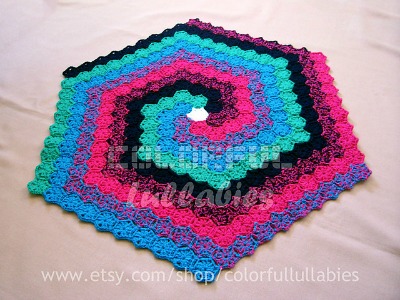This post is part of my 2012 Hispanic Heritage Month interview series.
Today, I’m interviewing Argentinian crochet designer Sara Palacios, the mind behind Arrorro en Colores (known as Colorful Lullabies in English).
This post contains affiliate links. I may receive compensation (at no added cost to you) if you make a purchase using these links.
Sara can be found online on her website, Ravelry (as SaraBea and in the Colorful Lullabies store), Etsy, Facebook, and Flickr. All pictures are used with her permission. Click on the images to be brought to the pattern in Sara’s shop.
Underground Crafter (UC): How did you learn to crochet?
Sara: I’ve liked handicrafts since I was a child. My mother was a dressmaker and I grew up watching her as she created new things, being passionate about fabrics, textures, shapes, and colors. When I was 10, she taught me the basics of crochet, knitting and embroidery. I also learned a lot from my aunts, who where always crocheting doilies, and from the craft magazines that they used to give me: they were the best gift I could get!
UC: When did you first become passionate about afghans?
Sara: At age 15, I crocheted a multicolor granny square using yarn remains and made a pillow with it. It was then that I discovered the magic of harmonizing colors and I wanted to crochet a blanket for my bed. This time I made it with new brightly colored wool. Since then, I came up with several ideas that I kept as projects to do some day, such as the illusions of stacked cubes. During the following 27 years, I crocheted some simple blankets and other things, but I did not realize any of these early projects because there was always something missing: time or money.
In 2008, I could make the first of the blankets I had been planning to do for so long. After that I could never stop imagining new things.

UC: What inspired you to start designing?
Sara: To copy other people’s models in an exact way – as beautiful as the model may have been – bored me. For example, I needed to combine the design of a pattern with a different stitch from another, and the colors of a flower in my garden. In other words, I needed to add something personal to it. And so, unexpected things started to come up. Any aspect of life that makes me feel passionate or that suggests beauty or excellence to me can be the source of inspiration for a crochet design: nature, art, dreams, maths, science or everyday experiences.

UC: Tell us about crochet in Argentina.
Sara: In general, crochet is picked up within the family as grandmothers, mothers and aunts teach you. However, today it is also learned through the Internet. In some places, they teach courses to learn or perfect crochet techniques. Usually, we learn both knitting and crochet but, as time goes by, we tend to choose crochet.
I believe that in the last years we, crocheters, are becoming more and more well-known, and we have started meeting in groups mostly thanks to social networks. In addition, there are also more young people crocheting nowadays.
This increasing popularity in crochet has to do in part with initiatives for solidarity that consist in getting granny squares of a certain size so as to make blankets to donate to hospitals and retirement homes. In particular the group Tejiendo por un Sueño (Knitting/Crocheting for a Dream) on Facebook gets thousands of knitters and crocheters together, and it also provokes an infectious enthusiasm that is both enriching and motivating. In this way more people want to crochet again which, the way I see it, has to do with the ‘magic’ of the granny squares: The possibility of combining colors, of giving new life and use to the leftovers of other handicrafts, of getting unique products and also of working with and for the community.
UC: Most of your patterns are available in English (both US and UK terms) and in Spanish. What made you decide to sell bilingual patterns?
Sara: I had always wanted to write patters, but I had never imagined myself doing it in English. I opened my shop on Etsy with the intention of selling blankets, but people started to ask me for the patterns, and so I decided to write them in both languages. I am happy to be able to share them with more people.

UC: Do you have any favorite Spanish or English language crochet or craft blogs to share?
Sara: Crochet soñado by Claudia Daneu is an Argentine blog with many video crochet patterns that explain very nice stitches and interesting variations. Tejido Crochet is another Argentine crochet blog with original designs and graphics. Mi Sala de Costura is a Spanish patchwork and craft blog, which also includes beautiful crochet patterns.
In English, I like Fiddlesticks and the crochet techniques of Vashti Braha, among other blogs. (UC comment: I’m a huge fan of Vashti’s blog and newsletter, and I also interviewed her back in January.)

UC: What’s next for Arroro en Colores?
Sara: I have a lot of projects. Most of my patterns are still in my head or in a draft. I crochet and write when I have free time to do it. I make my living working on computing with computers and crochet is just a hobby. I would like to be able to spend more hours on it, although I don’t want to hurry: crocheting is precisely about going slowly step by step.
Thanks so much, Sara, for stopping by to share your thoughts with us!


